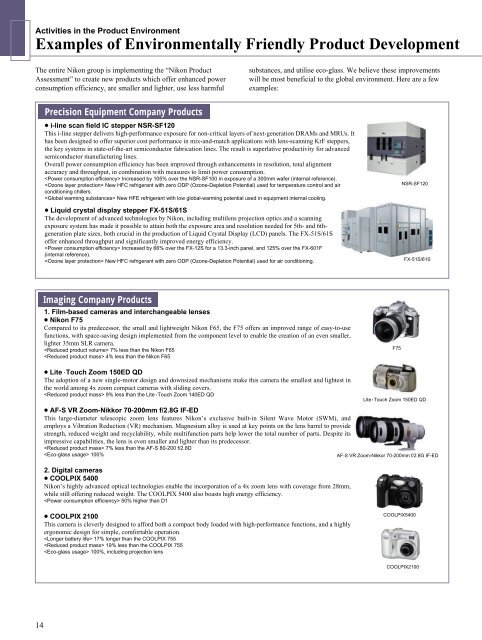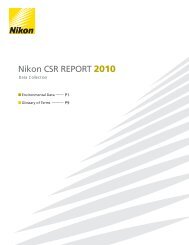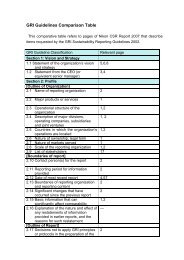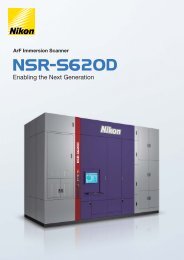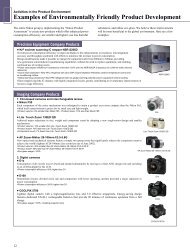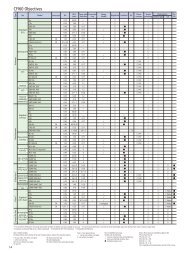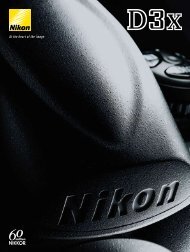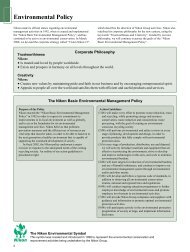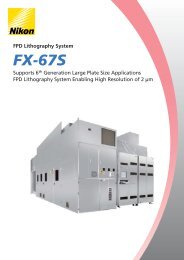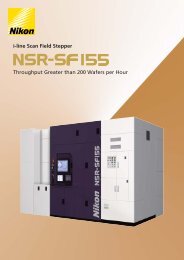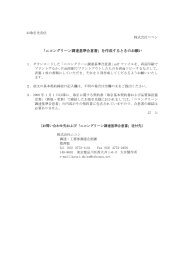Examples of Environmentally Friendly Product Development - Nikon
Examples of Environmentally Friendly Product Development - Nikon
Examples of Environmentally Friendly Product Development - Nikon
Create successful ePaper yourself
Turn your PDF publications into a flip-book with our unique Google optimized e-Paper software.
Activities in the <strong>Product</strong> Environment<strong>Examples</strong> <strong>of</strong> <strong>Environmentally</strong> <strong>Friendly</strong> <strong>Product</strong> <strong>Development</strong>The entire <strong>Nikon</strong> group is implementing the “<strong>Nikon</strong> <strong>Product</strong>Assessment” to create new products which <strong>of</strong>fer enhanced powerconsumption efficiency, are smaller and lighter, use less harmfulsubstances, and utilise eco-glass. We believe these improvementswill be most beneficial to the global environment. Here are a fewexamples:Precision Equipment Company <strong>Product</strong>s• i-line scan field IC stepper NSR-SF120This i-line stepper delivers high-performance exposure for non-critical layers <strong>of</strong> next-generation DRAMs and MRUs. Ithas been designed to <strong>of</strong>fer superior cost performance in mix-and-match applications with lens-scanning KrF steppers,the key systems in state-<strong>of</strong>-the-art semiconductor fabrication lines. The result is superlative productivity for advancedsemiconductor manufacturing lines.Overall power consumption efficiency has been improved through enhancements in resolution, total alignmentaccuracy and throughput, in combination with measures to limit power consumption. Increased by 105% over the NSR-SF100 in exposure <strong>of</strong> a 300mm wafer (internal reference). New HFC refrigerant with zero ODP (Ozone-Depletion Potential) used for temperature control and airconditioning chillers. New HFE refrigerant with low global-warming potential used in equipment internal cooling.• Liquid crystal display stepper FX-51S/61SThe development <strong>of</strong> advanced technologies by <strong>Nikon</strong>, including multilens projection optics and a scanningexposure system has made it possible to attain both the exposure area and resolution needed for 5th- and 6thgenerationplate sizes, both crucial in the production <strong>of</strong> Liquid Crystal Display (LCD) panels. The FX-51S/61S<strong>of</strong>fer enhanced throughput and significantly improved energy efficiency. Increased by 66% over the FX-12S for a 13.3-inch panel, and 125% over the FX-601F(internal reference). New HFC refrigerant with zero ODP (Ozone-Depletion Potential) used for air conditioning.NSR-SF120FX-51S/61SImaging Company <strong>Product</strong>s1. Film-based cameras and interchangeable lenses• <strong>Nikon</strong> F75Compared to its predecessor, the small and lightweight <strong>Nikon</strong> F65, the F75 <strong>of</strong>fers an improved range <strong>of</strong> easy-to-usefunctions, with space-saving design implemented from the component level to enable the creation <strong>of</strong> an even smaller,lighter 35mm SLR camera. 7% less than the <strong>Nikon</strong> F65 4% less than the <strong>Nikon</strong> F65F75• Lite Touch Zoom 150ED QDThe adoption <strong>of</strong> a new single-motor design and downsized mechanisms make this camera the smallest and lightest inthe world among 4x zoom compact cameras with sliding covers. 9% less than the Lite Touch Zoom 140ED QDLite Touch Zoom 150ED QD• AF-S VR Zoom-Nikkor 70-200mm f/2.8G IF-EDThis large-diameter telescopic zoom lens features <strong>Nikon</strong>’s exclusive built-in Silent Wave Motor (SWM), andemploys a Vibration Reduction (VR) mechanism. Magnesium alloy is used at key points on the lens barrel to providestrength, reduced weight and recyclability, while multifunction parts help lower the total number <strong>of</strong> parts. Despite itsimpressive capabilities, the lens is even smaller and lighter than its predecessor. 7% less than the AF-S 80-200 f/2.8D 100%AF-S VR Zoom-Nikkor 70-200mm f/2.8G IF-ED2. Digital cameras• COOLPIX 5400<strong>Nikon</strong>’s highly advanced optical technologies enable the incorporation <strong>of</strong> a 4x zoom lens with coverage from 28mm,while still <strong>of</strong>fering reduced weight. The COOLPIX 5400 also boasts high energy efficiency. 50% higher than D1• COOLPIX 2100This camera is cleverly designed to afford both a compact body loaded with high-performance functions, and a highlyergonomic design for simple, comfortable operation. 17% longer than the COOLPIX 755 19% less than the COOLPIX 755 100%, including projection lensCOOLPIX5400COOLPIX210014
Targets• Improvement in energy efficiency <strong>of</strong> 30% or greater for functions on products marketed during fiscal 2003,compared with products sold since fiscal 1998.• Reduction <strong>of</strong> models using ozone layer-damaging HCFC, used as refrigerant for IC and LCD steppers to fewer than30% <strong>of</strong> all products shipped in fiscal 2003, with ultimate goal <strong>of</strong> total elimination <strong>of</strong> use <strong>of</strong> HCFC by the end <strong>of</strong> fiscal 2005.Instruments Company <strong>Product</strong>s• CNC video measuring systems NEXIV VMR-10080, VMR-H3030The <strong>Nikon</strong> NEXIV VMR series <strong>of</strong> general-purpose, high-precision, non-contact measuring systems are capable <strong>of</strong>measuring 3D shapes such as electronic parts and precision components, using an optical head with high-power zoomoptics and laser auto-focusing, an automatic stage and image-processing capabilities.(See the NEXIV website at http://www.nexiv.net/eng/index_e.htm for specifications and applications <strong>of</strong> the NEXIVVMR series.)The new series employs LED light sources in place <strong>of</strong> halogen lamps, which greatly reduces generated heat and powerconsumption while enhancing precision. Measurement speed is doubled thanks to improved controllability, opticalcharacteristics and performance. 300% higher than the previous NEXIV models 82% in VMR-10080/79% in VMR-H3030 Number <strong>of</strong> halogen lamps has been reduced from six to twoNEXIV VMR-10080NEXIV VMR-H3030<strong>Nikon</strong> Group <strong>Product</strong>s• Fieldscope ED82 (straight body)/ED82 A (angled body)To meet the sophisticated needs <strong>of</strong> avid birdwatchers, these Fieldscopes <strong>of</strong>fer large, 82mm-diameter object lenses withmultilayer coatings and the bright, sharp imagery provided by a twe-piece ED lens. The waterpro<strong>of</strong> construction helpsprevent fogging and the growth <strong>of</strong> mould in the optical system even if it is pervaded by moisture, providing the durabilityand ease <strong>of</strong> use needed for field observation.The case has also been designed for outdoor use, coloured green to help avoid startling birds and other wildlife. Prisms andlenses use eco-glass, containing no lead or arsenic. 100% Bundled Stay-on case protects the body against shock; built-in slide hood; reinforced prism holders; waterpro<strong>of</strong>ing Most parts and servicing methods are identical to those <strong>of</strong> the existing Fieldscope III.• Surveying Instrument Pulse Laser Stations NPL-352/332The successor to the NPL-350, and sister to the DTM-352/332, this Series inherits the unsurpassed reliability <strong>of</strong> itspredecessors through water resistance and long-term field use. It also provides enhanced basic performance, user interface,and is capable <strong>of</strong> providing a 200m non-prism measurement distance, the longest in its class. 15% less than the NST-200N Series (battery life increased from 5.5 to 6.5 hours) 10% less than the NST-200N Series 91% (lead content <strong>of</strong> optics reduced from the 55.02g <strong>of</strong> the NST-200N Series to only 0.32g) The telescope does not have to be disassembled in order to repair the distance measurement system.The new Pulse Laser Stations also feature less complex optics, fewer adjustments, integration <strong>of</strong> electrical boards, simpler assembly andautomated electrical adjustments. These improvements facilitate assembly and significantly enhance repairability.ED82/ED82 ANPL-352/332NOTE: Most <strong>of</strong> the above products were introduced in Japan during fiscal year 2003.Future ActivitiesWe have established a rigorous system for environment-orienteddesign activities and enhancement <strong>of</strong> the ISO 14001-compliantenvironmental management system. We are applying this system tothe development <strong>of</strong> products, supported by the more aggressive<strong>Nikon</strong> EnvironmentalAction Plan(product environment)<strong>Product</strong> environmentalaspect evaluation(assessing currentsituation)See pages 10,11Environmental targets foreach product, programme toachieve targets“<strong>Nikon</strong> Environmental Action Plan” and “<strong>Nikon</strong> <strong>Product</strong>Assessment”, resulting in an entirely new level <strong>of</strong> environmentalfriendliness.In addition to using lead-free solders, we are striving to developproducts that are free <strong>of</strong> harmful heavy metals and polyvinyl chloride.<strong>Development</strong>and design<strong>Nikon</strong> <strong>Product</strong>AssessmentDesign review,productcommercialisationmeeting15
Activities in the <strong>Product</strong> EnvironmentContainers and PackagingTargets• 40% reduction in plastic containers used in consumer products in fiscal 2003,compared with figures for fiscal 1999.• Total elimination <strong>of</strong> non-separable multi-material for new packaging fromfiscal 2001 onward.<strong>Nikon</strong> defined its “Environmental Policy Regarding PackagingMaterials” in May 1998, and reviewed it in June 2000. This policyhas seven main points:1. Elimination <strong>of</strong> harmful substances. 2. Reduction in volume andcontent. 3. Recyclability. 4. Safety and ease <strong>of</strong> separation <strong>of</strong>materials. 5. Use <strong>of</strong> recycled resources. 6. Reusability. 7. Markingregarding packaging materials and handling precautions.The activities implemented based on this policy are asdescribed in the following chart:Non-vinylchloride filmTheme Policy Contents ApplicationPlant-derivedfiller materialsCushioning filmReinforcedcardboard boxesSingle-materialpresentation cases1. Elimination <strong>of</strong> harmfulsubstances2. Reduction in volume andcontent2. Reduction in volume andcontent2. Reduction in volume andcontent3. Recyclability5. Use <strong>of</strong> recycled resources4. Safety and ease <strong>of</strong>separation <strong>of</strong> materialsSwitch from use <strong>of</strong> vinyl chloride material, which is considered a majorsource <strong>of</strong> dioxin, to non-vinyl chloride materials such as polypropylene.Plant-derived filler materials are made from bean and wheat husks. Theyare significantly safer and more environmentally friendly filler materialsthan those derived from crude oil. We also use biodegradable resins inpackaging containing filler materials.Support with elastic film enables significantly reduced consumption <strong>of</strong>cushioning material.Adoption <strong>of</strong> reinforced three-layer cardboard boxes has enabled asignificant reduction in weight and volume <strong>of</strong> packaging in comparisonwith old-style wooden boxes.Use <strong>of</strong> film in presentation cases has been eliminated. Cases are nowmade from paper only, for ease <strong>of</strong> breakdown and decomposition.Wrapping materialsfor equipment suchas steppersGap filler(InstrumentsCompany products)CamerasStepper body(for shipping tocertain destinations)AccessoriesCushioning filmReinforced cardboard boxesAssembly-typepackagingSteel palletPulp mouldingDedicated transportcontainersPolyethylenebags4. Safety and ease <strong>of</strong>separation <strong>of</strong> materials4. Safety and ease <strong>of</strong>separation <strong>of</strong> materials6. Reusability5. Use <strong>of</strong> recycledresources6. Reusability7. Marking regardingpackaging materials andhandling precautionsSo far, we have achieved the following in our challenge to meet targets:• In fiscal 2002, use <strong>of</strong> plastic containers and packaging forconsumer products was reduced dramatically — 53% in weightagainst fiscal 1999 levels, through progressive use <strong>of</strong> pulpmoulding and other techniques. However, in fiscal 2003, itThe filler material and the cardboard are assembled manually for ease <strong>of</strong>separation later. Old-style packaging involved a fusing <strong>of</strong> different materials(cardboard and a crude-oil derived filler material).Smoke sterilisation process used with wooden pallets is no longer necessary.This also contributes to conservation <strong>of</strong> the forests.A paper filler material consisting <strong>of</strong> 55% recycled paper. This material isgradually being introduced as an alternative to crude oil derivatives.Dedicated containers are used for shipment to certain corporations.All packaging material is marked to facilitate separation. All bags, otherthan those <strong>of</strong> extremely small size, are marked with a warning <strong>of</strong>suffocation risk to infants.InstrumentsCompany productsStepperCameras, lenses,microscopesMicroscopesincreased to 95% in weight against 1999 levels, due to thedramatic growth <strong>of</strong> the digital camera business.• Through the use <strong>of</strong> single-material presentation cases andassembly-type packaging, as well as other methods, from fiscal2002 through 2003 we achieved our target <strong>of</strong> eliminating the use<strong>of</strong> non-separable multi-material for new packaging in fiscal 2003.Activities in the <strong>Product</strong> Environment<strong>Examples</strong> <strong>of</strong> Implementation in Sales and DistributionSteel palletPulp moulding<strong>Nikon</strong> is working tirelessly to reduce the total and long-termenvironmental impact <strong>of</strong> its products and services. Since <strong>Nikon</strong>supplies products worldwide, we must also pay strict attention tosales and distribution activities. The following are some examples<strong>of</strong> our reuse and recycling efforts in these areas:1. Sales <strong>of</strong> used steppers for reuse<strong>Nikon</strong> Tec Corporation has been collecting used steppers discardedby customers, and reconditioning and reselling them for new users,with the appropriate services supplied. This is an example <strong>of</strong><strong>Nikon</strong>’s willingness and capability to reuse its own products. Fiscal2003 saw 12 significant achievements, both domestically andabroad.<strong>Nikon</strong> is conducting in-depth research on the needs <strong>of</strong> thesemiconductor industry, in order to help companies in the field toexpand their businesses. This is another area in which ourdedication to environmental preservation, pr<strong>of</strong>itability and customerservice shines through.162. Recycling <strong>of</strong> packaging materials and batteries in Japan(1) Packaging materials<strong>Nikon</strong> have contracted the services <strong>of</strong> JCPRA (Japan Containersand Packaging Recycling Association) to collect and recyclepackaging materials used during the sale <strong>of</strong> <strong>Nikon</strong> products.(2) Batteries<strong>Nikon</strong> and many other companies have engaged in cooperativeefforts with JBRC (Japan Battery Recycling Center) to collect andrecycle rechargeable batteries for digital cameras and other productsdiscarded by consumers.3. Recycling <strong>of</strong> packaging materials and batteries in Europe(1) Packaging materialsOur overseas subsidiaries have contracted the services <strong>of</strong> DSD(Duales System Deutschland) to collect and recycle packagingmaterials used during the sale <strong>of</strong> <strong>Nikon</strong> products.(2) BatteriesOur overseas subsidiaries have contracted the services <strong>of</strong> GRS (StiftungGemeinsames Rücknahmesystem Batterien) to collect and recyclebatteries for cameras and other products discarded by consumers.


